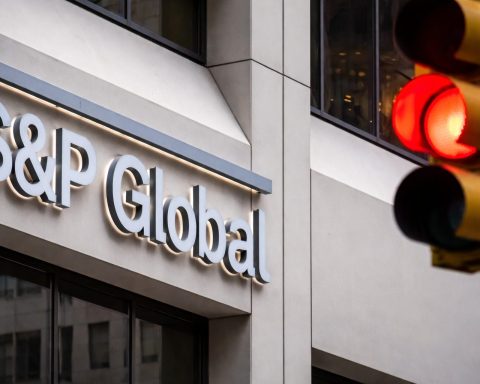- Gold-Fueled Surge: Newmont Corporation (NYSE: NEM) shares have soared to multi-year highs in 2025, at one point jumping roughly 150% year-to-date amid an unprecedented gold price rally [1] [2]. The stock hit a 52-week high near $98.6 per share in mid-October as gold prices breached $4,300/oz for the first time [3] [4], briefly pushing Newmont’s market capitalization above $100 billion [5].
- Recent Pullback: After peaking, gold’s sharp pullback this week (from an all-time high ~$4,381/oz on Oct. 20 down to ~$4,053 by Oct. 22) triggered a slide in miners [6] [7]. Newmont’s stock tumbled about 8–9% on Oct. 21 alone [8], and as of Oct. 24 it traded around the mid-$80s per share – still up over 130% for the year [9]. Analysts say the sudden drop is largely a technical “healthy pullback” after a parabolic run [10] [11].
- Earnings Beat & Caution: Newmont trounced Q3 earnings forecasts thanks to record gold prices, posting adjusted earnings of $1.71/share (vs. $1.44 expected) on $5.52 billion revenue [12] [13]. However, management warned that free cash flow will weaken in Q4 due to higher project and severance costs [14]. The mixed news saw Newmont’s stock dip ~2% after hours on Oct. 23 [15] and nearly 7% in pre-market trading the next day [16] [17], as investors digested the company’s cautious outlook.
- Analyst Outlook Divided:Wall Street remains broadly bullish on Newmont and gold miners, with multiple banks recently hiking price targets into the triple digits (e.g. BofA $115, Citi $104) and upgrading ratings amid the gold boom [18]. Some forecasts see gold topping $5,000/oz by 2026 [19] [20], which could further boost miners’ profits. “Ridiculously cheap” is how BlackRock’s Evy Hambro describes gold miner valuations relative to $4,000+ gold [21]. Still, short-term caution abounds: Citi sees a consolidation phase in coming weeks [22] and others warn the rally looks overextended, with near-term corrections likely as gold hits new highs [23] [24].
- Peers & Commodities Context: Newmont’s year-to-date performance outpaces most mining peers, though the tide has lifted all boats. Rival Barrick Gold’s stock is up roughly 98–115% YTD [25] [26], and AngloGold Ashanti skyrocketed ~226% – making it one of 2025’s top performers [27]. By contrast, diversified mining giant Rio Tinto has seen only modest gains, as its fortunes hinge on iron ore and copper. (Rio has, however, benefited indirectly from gold’s surge: soaring bullion prices lower its copper mining costs via by-product credits [28].) The backdrop for all miners is a historic gold boom – up ~60% in price this year on safe-haven demand, Fed rate-cut bets, and global tensions [29] [30] – alongside resilient prices for other commodities like silver and copper that support diversified miners.
Gold Rally Sends Newmont Soaring, Then Sliding
Newmont – the world’s largest gold producer – has ridden 2025’s gold rush to staggering heights. Spot gold prices blasted past $4,000 per ounce for the first time ever in early October and kept climbing to about $4,381/oz at their peak [31] [32]. This “record-busting rally” has been driven by a perfect storm of factors: investors seeking safety amid geopolitical strife (from Middle East unrest to U.S.–China trade tensions), fears of a potential U.S. government shutdown, and expectations that the Federal Reserve will start cutting interest rates as inflation cools [33] [34]. With real bond yields turning negative, the non-yielding metal suddenly looked attractive, and global central banks have been voracious buyers of gold in 2025 (on pace for over 1,000 tonnes of purchases) [35].
As the price of gold nearly doubled from prior peaks [36], gold mining stocks like Newmont became money machines. Newmont’s profit margins ballooned – every extra dollar on the gold price drops almost straight to miners’ bottom lines due to relatively fixed costs [37]. “Gold has never shone as brightly in investors’ eyes as it has this week,” quipped The Motley Fool, noting the metal’s surge on economic and political drivers [38] [39]. Newmont’s stock closely tracked bullion’s ascent, more than doubling in 2025 and vastly outperforming the broader equity market (the S&P 500 is up ~14% YTD) [40] [41]. By mid-October, NEM shares rocketed into the high-$90s – a level not seen in years [42]. In fact, Newmont briefly became the first gold miner ever to reach a $100 billion market cap [43], underscoring the “gold rush” euphoria in equity markets.
However, this golden run hit turbulence heading into late October. On Oct. 20, as gold reached fresh records above $4,380, some traders started taking profits [44] [45]. A swift correction in gold ensued – the steepest one-day drop in over a decade – sending the metal down about 5–6% on Oct. 21 [46] [47]. By Oct. 22, gold was hovering near $4,050/oz [48], still extremely high by historical standards but off the week’s highs. Gold’s sudden pullback reverberated through mining stocks: Newmont and its peers plunged 5–10% in a single day as the “momentum trade” in metals reversed [49]. Newmont slid roughly 8–9% on Oct. 21 [50], and continued to drift lower the next day [51]. At one point, the VanEck Gold Miners ETF (GDX) – a broad basket of gold miners – was down over 9% [52] [53].
Market watchers weren’t shocked by the volatility – after such a vertical ascent, a pullback was deemed inevitable. “The stock’s chart… appears clearly overextended,” noted Börse am Sonntag, observing that Newmont had been trading nearly 70% above its 200-day moving average before the drop [54]. Some technical indicators flashed overbought in mid-October (Newmont’s 14-day RSI popped above 80) [55]. As Josh Brown commented, Newmont’s rally looked like an “Empire State Building” – straight up [56]. With that in mind, analysts largely viewed the late-week dip as a healthy correction. UBS attributed gold’s retreat to technical factors rather than any fundamental crack [57], and Citi Research predicted a short-term consolidation over the next 2–3 weeks for miners after such a meteoric run [58]. In other words, some air coming out of the balloon now could set the stage for a more sustainable uptrend ahead [59].
Even after the recent pullback, Newmont’s stock is still up enormously this year – roughly +130% to +150% year-to-date by various estimates [60] [61]. Gold remains the hottest trade of 2025, up about 60% YTD [62] [63], and many catalysts that drove it (inflation fears, war tensions, central-bank buying) are still in play. As of Friday, October 24, Newmont stock traded around the mid-$80s, well below its highs but dramatically higher than its ~$35–$40 range at the start of the year. The question now: after this wild ride, what’s next for Newmont as it navigates record gold prices and its own operational challenges?
Record Earnings Powered by $4,000 Gold – and a Reality Check
Newmont’s financial results are finally catching up to the lofty gold prices – and the numbers are striking. In its third-quarter earnings report released October 23, Newmont blew past analyst expectations, leveraging the gold boom to deliver blockbuster profits. Adjusted earnings came in at $1.71 per share, handily beating consensus estimates of ~$1.44 [64] [65]. Revenue surged to $5.52 billion for Q3, about 6% above forecasts [66] [67], despite slightly weaker production volumes. For context, Newmont produced ~1.4 million ounces of gold in the quarter [68] – a bit lower than a year ago – but the average realized gold price jumped to ~$3,540/oz, up 40% from the prior year [69]. In essence, high prices masked any production softness. The company posted net income of $1.8 billion and a record $1.6 billion in free cash flow in Q3, its fourth straight quarter generating $1B+ in free cash [70] [71]. CEO Tom Palmer lauded the “robust” performance, noting the firm is also executing on cost cuts and efficiency initiatives to capitalize on this gold windfall [72] [73].
Yet, despite the blowout earnings, Newmont’s stock did not pop on the news – in fact, it slipped. Why? Investors zeroed in on management’s cautious guidance going forward. In the earnings release and call, Newmont warned that its free cash flow in Q4 2025 will be “adversely impacted” by several factors [74]. Notably, the company is spending more on a water treatment plant at its Yanacocha mine in Peru and will incur severance costs from recent layoffs, which will weigh on cash generation [75]. Essentially, even with gold above $4,000, Newmont signaled that its next quarter’s cash flow might dip below Q3’s level, disappointing some who expected accelerating returns. “Expectations were high… Now Newmont is warning Q4 cash flow will be weaker, which is disappointing when gold is above $4,000 an ounce,” said Tracey Ryniec, a stock strategist at Zacks Investment Research [76]. “The Street is asking, if you’re not crushing it now, when will you?” she added pointedly [77]. That sentiment captures the mild let-down: with a gold price bonanza, investors want to see correspondingly spectacular cash flows and shareholder payouts now, not later.
Newmont’s stock initially fell ~1.9% after the earnings announcement [78] [79], and extended losses into the next morning. By early Friday trading on Oct. 24, shares were down nearly 7% in pre-market activity [80] [81] as analysts digested the results. It appears some traders were banking on a “beat-and-raise” quarter; instead, they got a beat and some expense headwinds. Additionally, Newmont indicated its 2026 gold production is likely to come in at the lower end of prior forecasts [82] [83] – hinting at flat or modest growth outlook despite this year’s price tailwind. That conservative tone tempered enthusiasm.
Still, big picture, Newmont’s fundamentals are dramatically improved with gold at these levels. Profit and cash flow metrics are at multi-year highs. The company even maintained its quarterly dividend at $0.25/share (about 3% annual yield at current prices) [84], and has been reducing debt (paid down $2 billion this year) to shore up its balance sheet [85]. Newmont’s all-in sustaining costs of production are around $1,250/oz – so with gold $4k+, margins are enormous, above $2,000/oz. In fact, BlackRock observes that gold miners are now generating “enormous margins” at current prices [86] [87]. This helps explain why Newmont and others are talking about boosting shareholder returns. Analysts at RBC Capital Markets noted that many producers will likely be in a net cash position by Q3 and have ramped up share buybacks and dividends to reward investors [88]. Newmont itself has a buyback authorization in place and has reiterated confidence in its dividend coverage [89]. All of this suggests that while the market may fret about near-term costs or guidance, Newmont is fundamentally minting money at $4,000 gold – a fact that could support the stock after the initial earnings dust settles.
Short-Term vs. Long-Term: Where Do Experts See Newmont Heading?
With Newmont’s wild swings and mixed signals, analysts are divided between short-term caution and long-term optimism. In the near term, some cooling-off is expected. Technical analysts point out that after such a steep climb, Newmont’s momentum was due for a pause. Citi Research anticipates a brief consolidation in gold and mining stocks over the next few weeks [90], especially as traders await clarity on macro issues like a U.S. government funding deal and inflation data. Likewise, Nitesh Shah of WisdomTree commented that gold’s rally has been “aggressive” and predicted minor pullbacks with each new high [91] – a pattern we’ve now seen with the mid-October dip. This implies Newmont’s stock could remain choppy in the immediate future, especially if gold prices gyrate around the psychologically important $4,000 level. Some market watchers even warn that gold’s run may have gotten ahead of itself: Morgan Stanley strategists recently called gold’s surge a potential “bubble,” arguing that a lot of speculative money has piled in and could unwind if real interest rates rise again. Should gold prices retreat further or simply stall out, Newmont’s stock might languish or pull back to digest its gains (recall that some bulls suggested a mid-$80s pullback would be “healthy” when Newmont was near $100 [92] – which is roughly what has happened).
On the flip side, the long-term outlook from many experts remains decidedly bullish – both for gold and for Newmont. Wall Street analysts have been racing to upgrade gold miners in recent weeks amid the bullion boom. Bank of America, for example, boosted its price target on Newmont to $115 (from $105) on Oct. 16 while reiterating a Buy rating [93]. Citigroup likewise jumped its target from $74 to $104 the day before [94]. Others including CIBC, UBS, RBC and Raymond James have all hiked their targets by ~30–40% during October [95], reflecting the dramatically improved earnings profile at higher gold prices. Even after Newmont’s recent dip to ~$85, these targets imply substantial upside if the gold rally holds.
Critically, many analysts are extrapolating that today’s gold strength will persist or even intensify. HSBC, Societe Generale, and Bank of America now forecast gold near $5,000/oz by 2026 [96], with HSBC saying a $4,600 average in 2026 is likely and $5k “very possible” [97]. Such scenarios would be bonanza territory for miners – likely driving even higher profits and stock values. “I would not be surprised to see gold get to $5,000/oz at some point next year,” says Jeffrey Christian of CPM Group, citing ongoing political turmoil and robust demand [98]. In that vein, BlackRock’s global thematic investing head, Evy Hambro, argues that gold mining equities still haven’t caught up to the metal’s jump [99]. He notes that many industry models and valuations are pricing gold around $2,200–$2,400 – barely half the current price – which makes miners look undervalued on a cash-flow basis [100]. Hambro famously called gold miners “ridiculously cheap” relative to their earnings potential at $4k gold [101], suggesting significant room for re-rating if investors believe high gold prices are here to stay. This view from a major asset manager implies that long-horizon investors could see Newmont as a bargain after this dip, provided they are confident the macro drivers for gold (like low rates, debt concerns, and geopolitical risks) will persist into 2026.
To be sure, not everyone is unabashedly bullish. Some analysts question whether miners can continue to execute well operationally to fully capitalize on gold’s price. Higher input costs (energy, labor) and any production setbacks could eat into margins if gold stabilizes or falls. There’s also the risk that if gold goes too high too fast, it could invite a correction (as history has shown with commodities). Thus far, Newmont has managed costs and even trimmed its capital spending outlook by $200 million for 2025 [102]. The company is also transitioning leadership – notably, it recently appointed Natascha Viljoen as its new CEO, the first woman to lead the company, in a move analysts viewed as a well-flagged, orderly transition [103]. Competitor Barrick, by contrast, saw a surprise CEO exit (Mark Bristow) last month [104], injecting some uncertainty in its direction. How Newmont’s new management steers the ship through this gold boom will be pivotal. So far, the strategy seems to be: maintain stable production, improve efficiencies, and return cash to shareholders via dividends and buybacks. If gold stays elevated, that could be a winning formula in the long run.
Newmont vs. Rivals: Barrick, Rio Tinto, AngloGold Ashanti
Newmont’s dramatic rise is part of a broader mining sector rally, but the scale differs across companies. Among gold-focused peers, Barrick Gold (NYSE: GOLD) is the most directly comparable rival. Barrick’s stock has nearly doubled in 2025 – up about 98% to 115% year-to-date according to various measures [105] [106]. That’s an excellent return by any standard, though a notch below Newmont’s ~130%+ surge. Barrick’s slightly smaller gain may reflect its different asset mix (it produces a lot of copper in addition to gold) and some company-specific events. Notably, as mentioned, Barrick’s longtime CEO unexpectedly stepped down in September, which caused a brief wobble in its shares [107]. Still, with gold’s strength, Barrick is also set to report windfall earnings – analysts expect it and Newmont together to rake in nearly $3 billion in combined Q3 profits, more than double the year-ago level [108] [109]. Barrick has been rewarding shareholders as well; it paid a $0.15 dividend (with a performance component) and returned $753 million in H1 2025 [110]. Analysts generally view Barrick positively, especially with a new CEO incoming who could refocus the company’s strategy on key projects like the giant Reko Diq copper-gold deposit in Pakistan [111]. In short, Barrick is riding the same gold wave, though its stock’s momentum was slightly dampened by leadership uncertainty and a lower starting base.
A standout performer this year is AngloGold Ashanti (NYSE: AU). While smaller than Newmont or Barrick, AngloGold’s stock has exploded ~226% higher in 2025 [112] – outpacing even Newmont. Investors have flocked to AngloGold as it underwent a major corporate relocation (moving its primary listing to the U.S.) and benefitted from huge operating leverage to gold’s price in its African mines. The stock’s more-than-tripling reflects both the rising gold tide and company-specific improvements after years of underperformance. It also underscores that mid-tier and emerging market gold miners have seen outsized gains (South Africa’s gold index, for example, is having its best year in decades as mining shares soar [113]). Of course, such a rapid ascent can cut both ways – AngloGold might be more volatile on any gold price swings or operational hiccups. But year-to-date, it has rewarded shareholders the most among major gold miners, vindicating those who took on its higher risk for higher reward.
In comparison, Rio Tinto (NYSE: RIO) provides an interesting contrast as a diversified mining behemoth less tied to gold. Rio Tinto’s fortunes depend primarily on commodities like iron ore (its biggest product), copper, aluminum, and others – resources that haven’t seen the same uniform price explosion as gold. Iron ore, for instance, has faced headwinds from fluctuating Chinese demand in 2025, and copper prices, while solid, have not doubled. As a result, Rio Tinto’s stock has seen much more modest gains this year (roughly in line with the broader stock market, far below the gold miners’ rally). However, Rio isn’t untouched by the gold boom: it actually produces some gold as a byproduct of its copper operations, and the gold price surge is giving a small boost to Rio’s bottom line by lowering its reported copper unit costs (higher gold byproduct credits mean Rio can offset more of its copper production costs) [114] [115]. Citi analysts noted this gold tailwind helped Rio cut its copper cost guidance for 2025 (now $1.10–$1.30 per pound, improved from prior $1.30–$1.50) [116]. That said, Rio Tinto remains a different play – essentially a bet on global industrial growth and steel demand (via iron ore) with a dash of precious metals on the side. Its stock has not experienced anything like Newmont’s “gold fever” rally, illustrating how concentrated the 2025 gains have been in precious metal specialists versus diversified miners.
Looking ahead, investors in the mining sector will be weighing a few key factors across all these names: commodity price trajectories, cost control, and capital returns. If gold continues its march upward, one could expect Newmont, Barrick, AngloGold and others to keep outperforming, supported by jaw-dropping cash flows and possibly further dividend hikes or buybacks. If, however, gold falters or reverses, those high-fliers could see sharper corrections (just as they saw sharper gains). Diversified players like Rio might provide a cushion in that scenario since they’re less gold-dependent, but they carry their own exposure to economic cycles (e.g. if a global recession hits, base metal prices and iron ore could fall).
At present, the commodity context remains favorable for miners: gold is still near historic highs around $4,100 [117], silver and copper prices are elevated, and even energy prices have eased from peaks (helping mining operating costs). The global economy is showing mixed signals – robust enough to keep demand for materials reasonably strong, but with enough uncertainty (wars, inflation, interest rate pivots) to keep safe-haven interest in gold alive. This unusual combination has made 2025 a banner year for gold miners in particular. As one fund manager put it, “gold is trading at the intersection of inflation fears and stock market strength”, offering a bit of both offense and defense in portfolios [118] [119].
For Newmont shareholders, the ride has been exhilarating and nerve-wracking in equal measure. The stock’s rapid climb and recent dips showcase gold’s notorious volatility. Still, with expert forecasts calling for even higher highs in bullion and Newmont’s own operations streamlined for efficiency, many see the company as well-positioned heading into 2026. The balance of opinion among analysts leans positive: as long as gold stays anywhere near current levels, Newmont is poised to continue delivering strong earnings and returning cash to investors. Or as BlackRock’s Hambro suggests, unless gold prices collapse, the value in gold mining stocks is still compelling at these levels [120]. The next few weeks will test the short-term nerves of traders, but for long-term believers in the “new gold era,” Newmont’s story might just be beginning a shiny new chapter.
Sources: Reuters [121] [122] [123]; Bloomberg; CNBC; TS2.tech [124] [125] [126]; Investing.com [127] [128]; Company filings.
References
1. ts2.tech, 2. ts2.tech, 3. ts2.tech, 4. ts2.tech, 5. ts2.tech, 6. ts2.tech, 7. ts2.tech, 8. ts2.tech, 9. ts2.tech, 10. ts2.tech, 11. ts2.tech, 12. www.investing.com, 13. www.investing.com, 14. www.reuters.com, 15. www.reuters.com, 16. www.reuters.com, 17. www.reuters.com, 18. ts2.tech, 19. ts2.tech, 20. ts2.tech, 21. ts2.tech, 22. ts2.tech, 23. ts2.tech, 24. ts2.tech, 25. www.reuters.com, 26. ts2.tech, 27. ts2.tech, 28. www.fastbull.com, 29. ts2.tech, 30. ts2.tech, 31. ts2.tech, 32. ts2.tech, 33. ts2.tech, 34. ts2.tech, 35. ts2.tech, 36. ts2.tech, 37. ts2.tech, 38. ts2.tech, 39. ts2.tech, 40. ts2.tech, 41. ts2.tech, 42. ts2.tech, 43. ts2.tech, 44. ts2.tech, 45. ts2.tech, 46. ts2.tech, 47. ts2.tech, 48. ts2.tech, 49. ts2.tech, 50. ts2.tech, 51. ts2.tech, 52. ts2.tech, 53. ts2.tech, 54. ts2.tech, 55. ts2.tech, 56. ts2.tech, 57. ts2.tech, 58. ts2.tech, 59. ts2.tech, 60. ts2.tech, 61. ts2.tech, 62. ts2.tech, 63. ts2.tech, 64. www.investing.com, 65. www.investing.com, 66. www.investing.com, 67. www.investing.com, 68. www.investing.com, 69. www.investing.com, 70. www.investing.com, 71. www.investing.com, 72. www.investing.com, 73. www.investing.com, 74. www.reuters.com, 75. www.reuters.com, 76. www.reuters.com, 77. www.reuters.com, 78. www.investing.com, 79. www.investing.com, 80. www.marketscreener.com, 81. www.reuters.com, 82. www.reuters.com, 83. www.reuters.com, 84. www.investing.com, 85. www.investing.com, 86. ts2.tech, 87. ts2.tech, 88. www.reuters.com, 89. ts2.tech, 90. ts2.tech, 91. ts2.tech, 92. ts2.tech, 93. ts2.tech, 94. ts2.tech, 95. ts2.tech, 96. ts2.tech, 97. ts2.tech, 98. ts2.tech, 99. ts2.tech, 100. ts2.tech, 101. ts2.tech, 102. www.investing.com, 103. www.reuters.com, 104. www.reuters.com, 105. www.reuters.com, 106. ts2.tech, 107. www.reuters.com, 108. www.reuters.com, 109. www.reuters.com, 110. www.reuters.com, 111. www.reuters.com, 112. ts2.tech, 113. www.mining.com, 114. www.fastbull.com, 115. www.fastbull.com, 116. www.fastbull.com, 117. ts2.tech, 118. ts2.tech, 119. ts2.tech, 120. ts2.tech, 121. www.reuters.com, 122. www.reuters.com, 123. www.reuters.com, 124. ts2.tech, 125. ts2.tech, 126. ts2.tech, 127. www.investing.com, 128. ts2.tech







